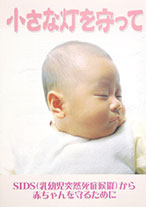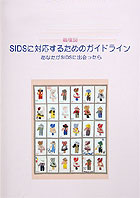Home > Recent Projects > Past Projects
Past Projects
Past Projects
Publicity and Fundraising
The SIDS Family Association Japan (SIDSFAJ) is a not-for-profit, volunteer organization that operates its projects and activities by raising funds through membership fees and donations. The SIDSFAJ works to constantly keep the organization and SIDS issues in the newspapers and magazines. We also regularly contribute articles to scientific magazines about the psychological care of bereaved families.
Our Head Medical Advisor, Dr. Hiroshi Nishida, started a "Running Journey" in February of 2004. In three months he ran the 2500 kilometers from Rome to Istanbul. He has continued his run from the spring of 2005 from the interior of China along the Silk Road, stopping at various places along the way to give lectures on nurturing babies and small children. This project has mainly been sponsored by Aprica and the theme is "Warm-heartedness to Children." Dr. Nishida has collected funds for the SIDS Family Association Japan through pledges per kilometer. His incredible journey ended on December 13th, 2008 in Nara, Japan. We have been truly inspired by his strength and generosity!
SIDSFAJ maintains a website in Japanese to give information about our organization and to disseminate information on SIDS and stillbirth. The address is: http://www.sids.gr.jp (only for systems that can read Japanese characters).
Survey of Bereaved Families in Japan
Though the SIDS rate continues to decline, there are thousands of families that suffer miscarriage, stillbirth and infant death in Japan each year. Do they receive adequate care during their painful experience? We designed questionnaires to determine the kind of care that families are presently receiving. The first questionnaire was given to our bereaved family members. The results showed what they experienced at the time their babies died. Using this as a base, we designed other questionnaires that were sent to obstetricians, pediatricians and daycare centers. The results of these surveys confirmed the results of the bereaved parent survey and taught us about the attitudes and the problems that caretakers face when a baby dies. The results of all of these surveys showed clearly that there is virtually no follow-up care for families after the death of a baby in Japan.
Armed with the results of this survey, we can now start work on finding ways to create a system for follow-up care. The results of the surveys to caretakers (obstetricians, pediatricians and daycare workers) taught us about the problems we will face as we work on implementing a system. Most medical professionals do not feel comfortable introducing a counselor or support group because most do not have training in dealing with bereaved families. Also they do not have official permission from their administration to introduce counselors or support groups. There are also some cultural constraints. There was an attitude among some participants that a family's privacy should not be invaded, especially at such a painful time. This might be related to the Japanese cultural taboo on dealing with problems outside of the family. It is also possibly related to the common perception that counseling is for extremely ill people. It was felt that bringing up the topic of follow-up psychological care might embarrass or insult the bereaved family.
However, the results of the parent survey showed that the bereaved did indeed want follow-up care. Part of our job will be to respect these attitudes while helping to set up a system of care.
The SIDS Prevention Campaign

The SIDS Family Association Japan launched a SIDS prevention campaign in June of 1996 targeting medical professionals. In early 1997 a pamphlet was released that educated new parents about SIDS risk factors. These were distributed to hospitals and daycare centers. The pamphlet encouraged parents to do the following to lower the risk for their baby:
- Sleep the baby on the back
- Do not smoke near the baby or during pregnancy
- Breastfeed as much as possible
- Do not leave the baby alone when asleep

The pamphlet urges parents to sleep the baby in the same room with parents, to avoid leaving the baby alone, to avoid sleeping the baby in unusual places like a sofa, and to avoid soft toys and pillows in the sleep area.
The pamphlet also reassures parents that SIDS is relatively rare so parents should not feel stressed about the child care environment but should do what they can to keep it risk free and enjoy parenting as much as possible.
A reduction in these risk factors in countries overseas has led to a dramatic decrease in the number of SIDS deaths. In Japan in 1998 a decrease in the SIDS rate by 25% was achieved as the message of the campaign began to change childcare practices. The SIDS Family Association was awarded funds from the Japanese Ministry of Health and Welfare to co-produce a new version of the prevention pamphlet.
This was followed by a new version of the booklet "Guidelines for Care of Bereaved Families" and an 18-minute video "How to Protect Against SIDS" that covers the risk information about SIDS and information on feelings of bereaved parents. Over 7000 copies of this video were distributed to health care centers across the nation in late 2000. Over two million copies of the prevention pamphlet have been distributed since 1998. By 2001, the SIDS rate in Japan had been reduced by almost 50%. The latest version of the prevention pamphlet gives information on the falling SIDS rate:
SIDS RATE JAPAN (Per 1000 live births, birth to 1 year)
| Year | 1995 | 1996 | 1997 | 1998 | 1999 |
|---|---|---|---|---|---|
| SIDS Rate Japan | 0.443 | 0.395 | 0.416 | 0.299 | 0.31 |
| Number of Deaths | 526 | 477 | 496 | 360 | 365 |
| IMR | 4.3 | 3.8 | 3.7 | 3.6 | 3.4 |
| Year | 2000 | 2001 | 2002 | 2003 | 2004 | 2005 | 2006 | 2007 | 2008 |
|---|---|---|---|---|---|---|---|---|---|
| SIDS Rate Japan | 0.265 | 0.248 | 0.219 | 0.194 | 0.193 | 0.164 | 0.162 | 0.135 | 0.14 |
| Number of Deaths | 315 | 290 | 253 | 218 | 214 | 174 | 177 | 147 | 153 |
| IMR | 3.2 | 3.1 | 3.0 | 3.0 | 2.8 | 2.8 | 2.6 | 2.6 | 2.6 |
